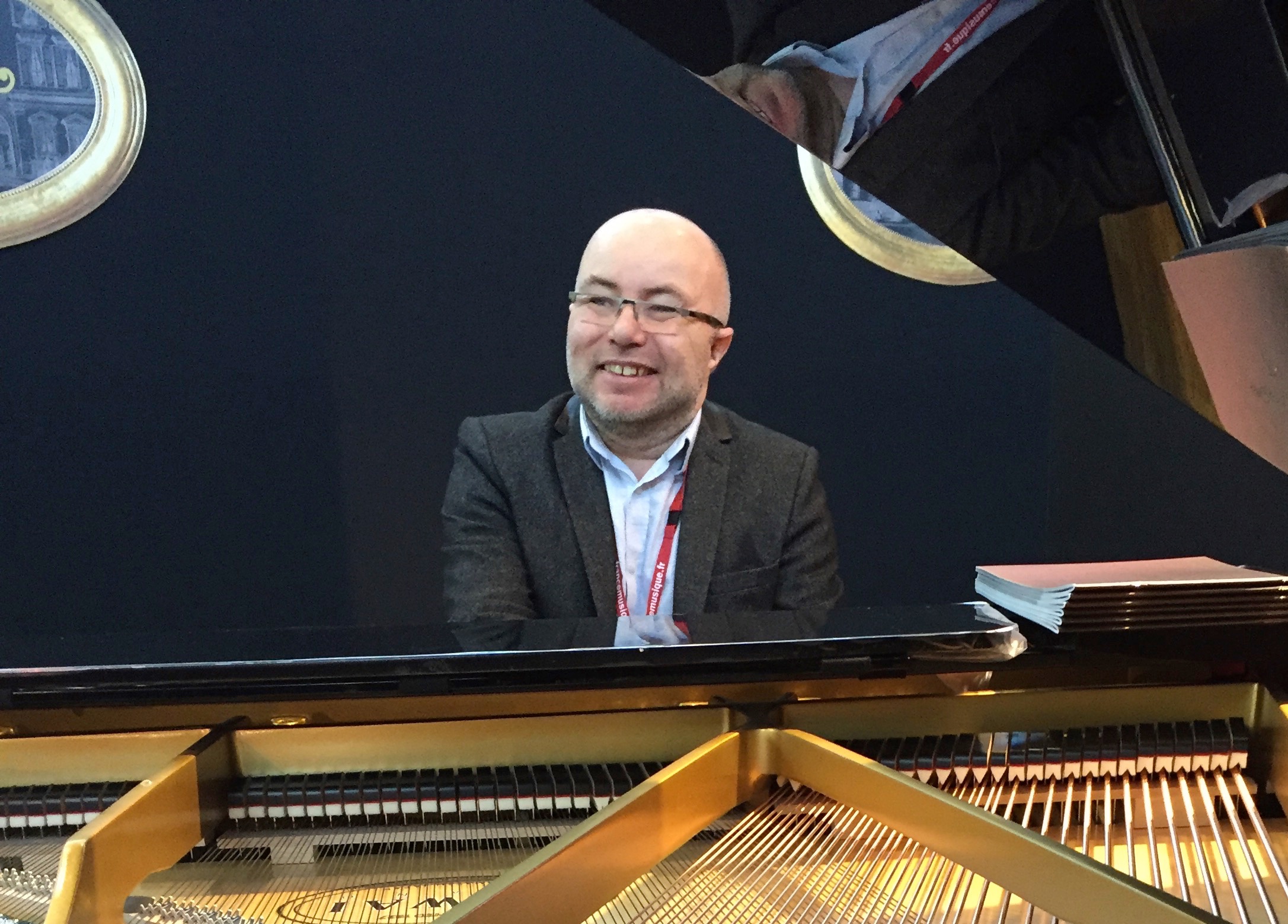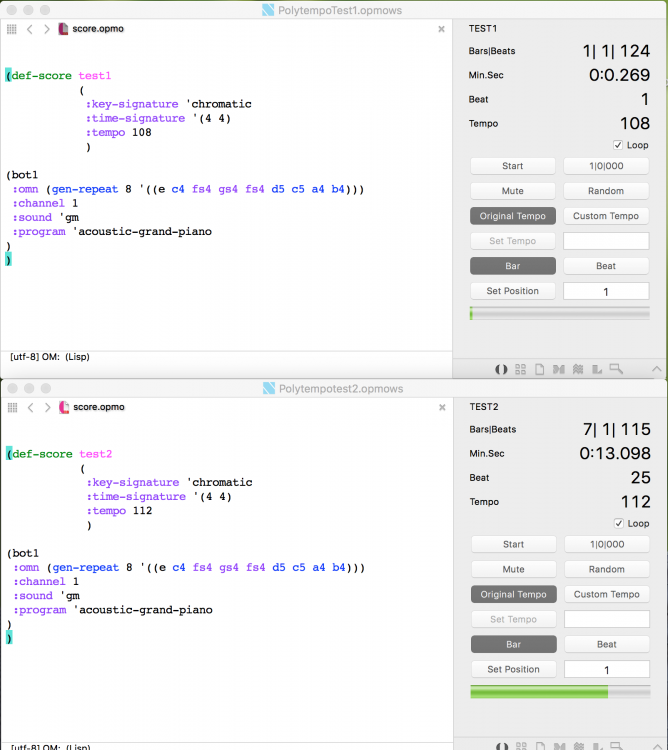-
Posts
1,070 -
Joined
-
Last visited
Content Type
Forums
Events
Store
Video Gallery
Everything posted by Stephane Boussuge
-
Hi, may be your base material is 12 bars long ? S.
-
by the way, if you want to use degree from scales you wrote the chords progression as degree like this: (setf scale '(c4 d4 e4 f4 g4 a4 b4)) (collect-degree-from-scale '(1 4 5 1 4 2 5 1) scale :nb-sounds '(3 3 4 3 3 3 3 4)) SB.
-
Hi, this may help: ;; Utility function (defun collect-degree* (nb steps list) (loop for n from 0 to (+ nb 2) by steps collect (nth n list))) ;(collect-degree* 3 2 scale) ;(collect-degree* 5 2 (pitch-rotate 6 scale)) ;;; DEGREE (defun degree (n-degr scale &key (sounds 3) (steps 2)) (chordize (collect-degree* sounds steps (pitch-rotate (- n-degr 1) scale)))) ;;; Usage #| (degree 1 scale) => '(c4e4g4) (degree 1 scale :sounds 4) => '(c4e4g4b4) (degree 1 scale :sounds 5) => '(c4e4g4b4d5) (degree 4 scale :sounds 4) => '(f4a4c5e5) |# ;;; COLLECT-DEGREE-FROM-SCALE (defun collect-degree-from-scale (deg-list scale &key (nb-sounds '(3)) (steps '(2))) (loop for d in deg-list for nbs in (gen-trim (length deg-list) nb-sounds) for stps in (gen-trim (length deg-list) steps) collect (degree d scale :sounds nbs :steps stps))) ;;; Usage #| (collect-degree-from-scale '(1 4 5 1 4 2 5 1) scale :nb-sounds '(3 3 4 3 3 3 3 4)) (setf scale2 (integer-to-pitch (expand-chord-name 'arezzo-major-diatonic-hexachord))) (collect-degree-from-scale '(1 4 5 1 6 4 2 5) scale2 :nb-sounds '(3 3 4 3 3 3 3 4)) (setf row (rnd-row :type :pitch)) (mapcar 'sort-asc (collect-degree-from-scale '(1 4 5 1 6 4 2 5) row :nb-sounds '(3 3 4 3 3 3 3 4))) |# SB.
-
Yes, absolutely true. S.
-
Hi, key signature in score def is for the specification of number of sharp or flat in score notation. for example '(f maj) = 1 flat, (d maj) = 2 sharp etc... S.
-
New Score for piano Solo, "Image 1". SB. Image-1_02_060116_1314 - Partition complète.pdf
-
Hi, Most all of my tutorials videos have english subtitles, only the conferences doesn't have. About your questions: 1. for the :sound option, reaktor mean : "use the soundset named reaktor who is present in the library folder." Please, look into the library , you will find the corresponding soundset file named Reaktor.lisp 2.Yes, the port need to be Uncommented indeed for the system be able to send to data to it. in the example, it is commented but it is an error. For driving Reaktor or any other plug, it need to be uncommented. 3.Indeed, something goes wrong with Reaktor 6, this file example was made on an earlier version... now, if you look on the connection active on the steam pipe in Reaktor6, you will find only this controllers used: 5, 10, 18, 55,71, 74 here's another example based on the controller1 example but a little bit adapted: (setf len 20) (setf length (gen-length (rnd-sample len (append (gen-eval len '(rnd-sum 8 '(1 2 3))) (gen-eval len '(rnd-sum 5 '(1 2 3))) (gen-eval len '(rnd-sum 4 '(1 2 3))) (gen-eval len '(rnd-sum 6 '(1 2 3)))) :seed 34) (rnd-sample len '(16 20 8 24) :seed 34) :repeat (rnd-sample len '(5 8 4 6 5 3 8 5 6)) :rnd-order t)) (setf pitch (gen-chord 13 1 2 0 0 (row-variant (rnd-sample len '(0 1 2 3 4 5 6 7 8 9 10 11)) (rnd-sample len '(o r4 i r ri)) '(0 8 11 10 2 1 4 3 7 6 9 5) :type :pitch))) (setf velocity (get-velocity (rnd-number len 30 90))) (setf elec (make-omn :length length :pitch pitch :velocity velocity :flat t)) (def-score reaktor (:key-signature 'chromatic :time-signature '((1 1 1 1) 8) :tempo 120 :start 1 :end 16) (inst :omn elec :port 0 :channel 1 :sound 'reaktor :program 8 :pan '((:desc-asc 127 0 1/32 5) (:asc 34 127 1/32 5) (127 1) (0 1)) :volume 127 :controllers (5 '((4 1) (3 1/2) (65 1/2)) 10 '((0 2) (80 1/2) (65 1/2)) 18 '((:desc-asc 76 23 1/32 3) (:asc 34 127 1/32 2) (127 1) (0 1)) 55 (rnd-sample 100 '(23 45 12 89 94 2 57 21)) 71 '((:desc-asc 127 0 1/32 3) (:asc 34 127 1/32 5) (127 1) (0 1)) 74 '((67 1) (7 1/2) (64 1/2)) ) ) ) 4. Indeed, 55 goes to the reverb, but you need send normal midi values because it is controllers value because reaktor want it and it will rescale them accordingly . 5. in that case, for list of controllers value, they are send one by event (note). best wishes, Stéphane
-
Hi, you can have a look in Howto section to documents: controllers1 and controllers2, it could probably help. If you need more help, don't hesitate to ask me. SB.
-
This parameters are tied to soundset files (in Library folder). A soundset file is a file with description of Bank, Program change cc etc for a virtual instrument (plugin or hardware ) you pilot via :port. You can have a look to Tutorial stage No. 26 for basic soundset example. SB.
-
Happy new Opusmodus year to all of you ! S.
-

score Fibonacci's Meditation
Stephane Boussuge replied to Stephane Boussuge's topic in Made In Opusmodus
Thank you Robert S. -
An ambient piece based on a Fibonacci series. SB. FibonacciMeditation.opmo
-
You can utilize :shift optional keywords parameters and :closest 'down etc... TONALITY-MAP have a lot of optional possibilities. SB.
-
Hi, Here's a Strings Trio composed in memory of the victims of Paris attack. Attached Part-a and part-d opmo scores for study purpose. S.B st-a.opmo st-d.opmo
-
also you may be interested by this example: ;; An example of diatonic transposition ;; ie. using tonality degree for tonality mapping. ;; degree selection (setf degr '(1 4 2 5 1 6 4 2 5)) ;; remove 1 from each degree for use as transposition ;; inside tonality for diatonic transposition (setf trsp (mapcar (lambda(x) (- x 1)) degr)) ;;; some material (setf arps1 (gen-repeat (length degr) '((s c4 e4 g4 c5 e5 g5 c6 g5 e5 c5 g4 e4)))) ;; apply diatonic transposition (inside tonality) (setf arps.map (tonality-map '(major :root d4) (pitch-transpose trsp arps1))) SB.
-
Hi, you can do eventually polytempo with Live Coding, using many instance (workspaces) of Opusmodus. here's attached a picture example with 2 instances of LCI (LiveCodingInstrument)/ Hope this can help. SB.
-

audio Orchestral media Music Production test
Stephane Boussuge replied to Stephane Boussuge's topic in Made In Opusmodus
Thank you SB. -
A quick and dirty test of Opusmodus possibility and capability for Media Music Production. Test successful. Setup is Opmo driving EastWest Hollywood orchestra in Vienna ensemble Pro. Output is the direct output from Opusmodus/EastWest. Naturally this output is just a prototyping and need much more attention (it would be good someday to redo the clarinet part etc..) but it was just a test of a personal Orchestral setup. SB.
-
Hi, Here's a Duet for Violin and Piano. Music score and opmo. script attached to this post. SB. DuoViolonPiano101015-1.pdf s1.opmo
-
Very impressive and interesting score. I agree with Janusz about annotations thank you for sharing this great score. S.
-
i am very happy to know you learn from my scores. Great ! Stf
- 4 replies
-
- orchestral
- tv
-
(and 2 more)
Tagged with:
-
Opusmodus is not only a wonderful tool for composing contemporary art Music, it can be also a very good tool for composers working for Tv or other media. Attached, a score script extract of this soundtrack score for tv made with Opusmodus. It is the section from 1'28 to 1'43 on the Soundcloud file below. LeDuc2.opmo
- 4 replies
-
- orchestral
- tv
-
(and 2 more)
Tagged with:
-
you can use ratio as well for length like 32/8 etc ... S.


